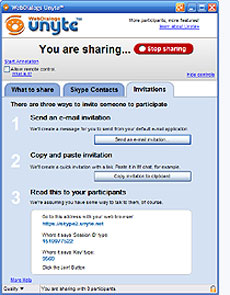Unyte equips Skype for true conferencing


I have to confess I was one of the skeptics. My reason for skepticism is that the more participants on such a call, the more likely that- at least insofar as enterprise calls are concerned- more data needs to be exchanged during the call. With that realization, I wondered why, say, a 4-participant conference call where PowerPoints and JPEGs needed to be shown should be conducted over Skype rather than a more robust hosted solution such as WebEx. Or even, for that matter, over a company-owned Microsoft Live Communications Server.
But that skepticism came before a conversation last week in San Diego with Lou Guercia, president and CEO of WebDialogs. He described Unyte, and I have been working with it as well.
The more familiar I get with Unyte from WebDialogs, I have been visualizing the type of Skype sessions that would enable enterprise users not only to save phone charges via Skype, but to share documents and presentations as well.
Unyte works as a plug-in for Skype. Once you install it, you can fire up a Unyte session from Skype chat or even from within your System Tray.
To start a session, you simply send participants the Unyte URL spawned for the session you are opening. Recipients with Skype can click on the Unyte URL to join the session. The basic Unyte service supports up to four participants.
For conferences with more participants, WebDialog's option is their Meeting Central web conferencing service. Meeting Central offers polling, audiocasting, and recording with annotation for conferences with up to 500 participants.